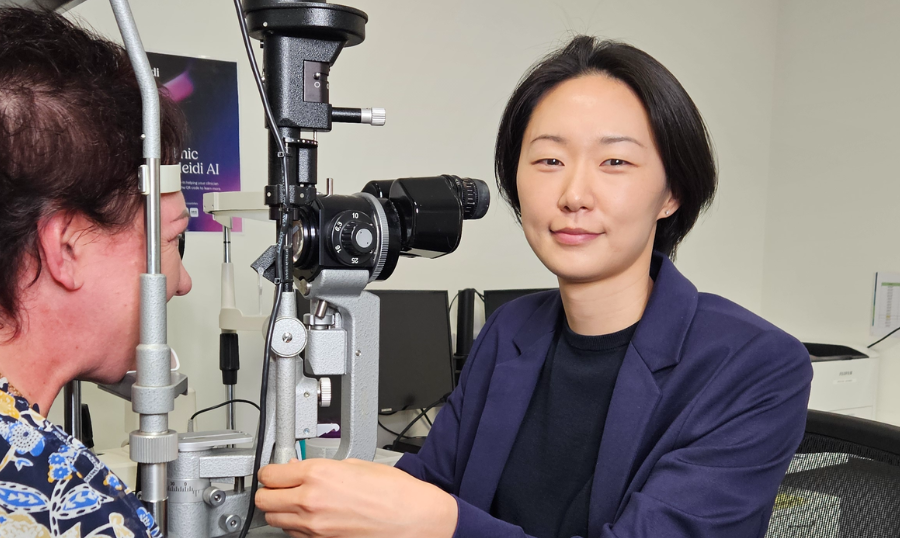Auckland Eye Welcomes Cornea and Anterior Segment Specialist Dr Bia Kim
Auckland Eye is pleased to welcome Dr Bia Kim, a highly trained Cornea and Anterior Segment Specialist, to our team.

The colour of our eyes depends on how much melanin is present in the iris. Blue eyes get their colour the same way water and the sky get their blue colour — they scatter light so that more blue light reflects back out.
The iris is made up of two layers. For almost everyone — even people with blue eyes — the back layer (called the pigment epithelium) has brown pigment in it.
The front layer of the iris (called the stroma) is made up of overlapping fibers and cells. For people with brown eyes, some of the cells also have brown pigment in them. If there is no pigment at all in this front layer, the fibers scatter and absorb some of the longer wavelengths of light that come in. More blue light gets back out and the eyes appear to be blue.
Melanin in the iris of the eye appears to help protect the back of the eye from damage caused by UV radiation and high-energy visible “blue” light from sunlight and artificial sources of these rays.
Since blue eyes contain less melanin than green, hazel or brown eyes, photophobia is more prevalent in blue eyes compared to darker coloured eyes. For these reasons, having less melanin in your irises means that you need to protect your eyes more from the sun’s UV rays. Therefore, it is recommended to those with blue eyes to stay out of the sun for long periods of time and try to wear protective eyewear when you are outdoors.
Originally we all had brown eyes, however, according to researchers at the University of Copenhagen, it appears that a genetic mutation in a single individual in Europe 6,000 to 10,000 years ago led to the development of blue eyes. Therefore, we can conclude that this genetic mutation is the cause of eye colour of all blue-eyed humans alive on the planet today.
What is the genetic mutation?
A genetic mutation affecting the OCA2 gene in our chromosomes resulted in the creation of a “switch”, which “turned off” the ability to produce brown eyes. The OCA2 gene codes for the ‘P protein’, which is involved in the production of melanin (the pigment that determines the colour of our eyes, skin and hair). The “switch”, does not, however, turn off the gene entirely, but rather limits its action to reducing the production of melanin in the iris – effectively “diluting” brown eyes to blue.
According to Hans Eiberg, associate professor in the Department of Cellular and Molecular Medicine from the University of Copenhagen,
“From this, we can conclude that all blue-eyed individuals are linked to the same ancestor. They have all inherited the same switch at exactly the same spot in their DNA.”
While blue eyes may be rare, they’re among the most common eye colours at birth. Since the human eye does not have its full adult amount of pigment at birth, most Caucasian babies are born with blue eyes. However, since human melanin tends to develop over time — this causes the child’s eye colour to change as more melanin is produced in the iris during early childhood.
A new study suggests that individuals with blue eyes are at a higher risk for alcohol dependency compared to those with darker eyes. Therefore, this finding adds further evidence to the idea that alcoholism has a genetic component.
A study published in American Journal of Medical Genetics, Part B: Neuropsychiatric Genetics found that European Americans with blue eyes had up to 83 percent higher odds of becoming dependent on alcohol, compared with matched controls who had darker eye colours. This research suggests that alcoholism has a genetic component linked to genetic sequences that determine eye colour, which may help explain the association. However, at this stage, the reason for the correlation is still unknown and further research is required to fully understand this correlation in the findings.
Since it was once believed that eye colour — including blue eyes — was a simple genetic trait, many people used to believe that blue-eyed people could only have blue-eyed children. Before geneticists fully understood how human eye colour inheritance works, a child’s eye colour to used be used as a paternity test — based on the assumption that you could predict a child’s eye colour if you knew the colour of the parents’ eyes and perhaps the colour of the grandparents’ eyes.
But geneticists now know that this concept is far more complicated, as eye colour is influenced by an interaction of as many as 16 different genes — not just one or two genes as once thought. Additionally, the anatomic structure of the iris can also influence eye colour to some degree.
In summary, it’s impossible to know for sure if your children will have blue eyes. Even if you and your partner both have blue eyes, that’s no guarantee your child’s eyes will also be blue. For instance, just take a look at the royal family for an example of the unpredictability of eye colour: Prince George the young son of blue-eyed Prince William and green-eyed Kate Middleton, has dark brown eyes. But his younger sister, Princess Charlotte, has blue eyes. Also, while Kate and William’s newborn son, Prince Louis, appears to currently have blue eyes, it is still early days and the world will have to wait and see if over time his eyes change colour!
Book an appointment with us today at admin@aucklandeye.co.nz or call us on 0800 25 53 93.

Auckland Eye is pleased to welcome Dr Bia Kim, a highly trained Cornea and Anterior Segment Specialist, to our team.

Discover how Auckland Eye is redefining inclusive healthcare by launching New Zealand’s first assistive website toolbar.

Macular degeneration is a leading cause of vision loss in older adults. There’s no cure, but its progression can be slowed. Here’s what to know.